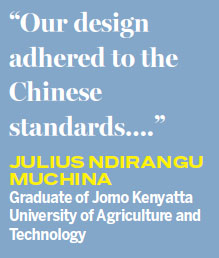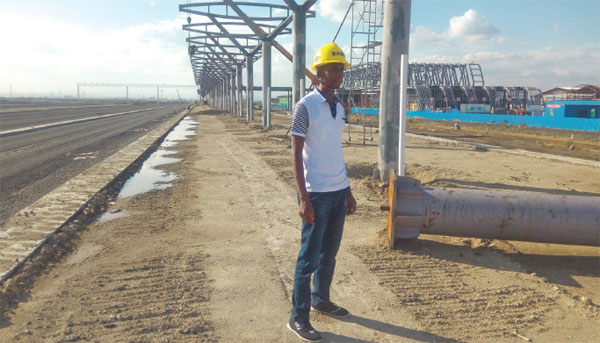'My lucky role in railway project'

Engineer feels fortunate to have played an important part in building key Kenyan link
When studying for engineering courses at a university, most graduates can only dream of being part of a large-scale project. Such projects were unheard of a decade ago in Kenya. The landscape is changing, however.
Julius Ndirangu Muchina considers himself lucky to be among the local engineers taking part in the construction of the Mombasa-Nairobi Standard Gauge Railway.
The easygoing 28-year-old graduate of Jomo Kenyatta University of Agriculture and Technology has overseen the building of the large-scale railway project from beginning to end. He admits that a lot of the technical work was very new to him, but he was able to keep up thanks to his five Chinese colleagues, who he says were patient and brilliant.
| Julius Ndirangu Muchina says he is lucky to take part in the construction of the Mombasa-Nairobi Standard Gauge Railway. Provided to China Daily |
"We would pore over the designs every morning before setting out," he says, adding that his colleagues would translate and explain installation instructions written in Chinese until he understood.
However, they would also rely on his skills as an architectural engineer with some skills in landscaping to translate blueprints written in English. They built a close-knit group that focused on quickly building the infrastructure and strictly observing quality controls.
According to China Road and Bridge Corp, comprehensive inspections were carried out on each section twice a month. There are eight sections along the route, and Ndirangu is based at section eight, which is about 25 minutes from downtown Nairobi. The inspection team would reward teams according to test results and punish sections with notable problems. This strategy kept the team on their toes, says Ndirangu.
He was therefore surprised when local engineers raised quality concerns in 2015, nearly a year after CRBC began the project. They accused the contractor of adhering to different standards, saying it compromised the strength of the structures.
"This was not true," says Ndirangu. "Our design adhered to the Chinese standards that prefer the use of concrete with minimal steel reinforcement over the British standards, which emphasize using steel when making culverts. These are two different standards."
He is astounded by the expertise and technology employed in the building of the infrastructure, which has been completed six months early. He also attributes this to the industriousness of the Chinese workers.
Kenya's dry and hot climate presented numerous challenges. The engineering team therefore devised a pier water conservation method to avoid cracks. They would put a bucket of water on top of the freshly finished structure and let the water trickle slowly over it to keep it humid at a certain controlled limit. This method guaranteed a strong structure afterward, says Ndirangu.

The father of one engineer who has worked with the Chinese company for three years says the project has massively scaled up his son's skills. In addition to providing on-site experience, CRBC sponsored him for a three week capacity-building seminar in Beijing that focused on train-related skills.
"More scholarships need to be provided to enable Kenyans to pursue train-related engineering studies in China," the father says. "This will be key in developing local capacity to manage the modern infrastructure and also equip them to work in other countries."
He believes that Kenya and other developing nations have a lot to learn in order to bridge the existing transport modernization gap. "I think sometimes it seems overwhelming, seeing what China has achieved over a very short period of time. But it is doable," he says.
The new infrastructure is scheduled to be commissioned by President Uhuru Kenyatta on May 31.
With the civil works of Mombasa-Nairobi more than completed, Ndirangu finds himself eager to embark on a new challenge when CRBC begins construction of the second leg of the project, which will link Nairobi to Naivasha. The 120-km extension, financed by the Export Import Bank of China, faces difficult terrain that crosses a national park. This means a super bridge must be built to avoid interfering with the migration of elephants.
The engineer is proud of the infrastructure, saying more jobs are bound to be created once it becomes operational. "More engineers will be employed to operate and maintain this infrastructure, and this buoys the hopes of students who are still in universities," he says.
He believes that his experience has made him more marketable and expanded his career opportunities.
Lucymorangi@chinadaily.com.cn
(China Daily Africa Weekly 05/12/2017 page21)
Today's Top News
- Experts: Lai not freedom fighter, but a pawn of the West
- Hainan evolves as gateway to global markets
- Opening up a new bridge between China and world
- Tour gives China-Arab strategic trust a boost
- China accelerates push for autonomous driving
- Opening of new gateway can help foster global economic and trade cooperation































